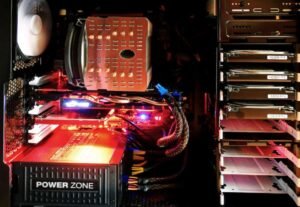Generative Art with Illustrator
Generative art, also known as algorithmic art, is a fascinating form of digital art that uses code or algorithms to create unique and evolving visual compositions. With Adobe Illustrator, one of the most popular graphic design software, you can explore the world of generative art and unleash your creativity. In this article, we will dive into the basics of generative art and how to create stunning artwork using Illustrator.
Key Takeaways
- Generative art uses code or algorithms to create unique and evolving visual compositions.
- Adobe Illustrator is a powerful tool to create generative art.
- Generative art allows artists to explore new creative possibilities.
Understanding Generative Art
Generative art is a process where an artist creates art that is generated by a set of rules or algorithms. These rules can be mathematical equations, randomization techniques, or even machine learning algorithms. Each time the code is executed, a new and unique artwork is created. This constant evolution and unpredictability are what make generative art so exciting.
Generative art blurs the line between human creativity and the capabilities of computers, allowing artists to explore new creative possibilities. By using algorithms to drive the creation process, artists can tap into a world of endless variations and produce complex and mesmerizing artwork.
Generative art empowers artists to collaborate with algorithms and embrace the unexpected.
Creating Generative Art with Illustrator
Adobe Illustrator provides a wide range of tools and features that can be used to create generative art. From basic geometric shapes to complex patterns and textures, Illustrator offers a versatile platform for artists to experiment and express their artistic vision.
To start creating generative art with Illustrator, you can begin by familiarizing yourself with the various tools and functions such as the Pen Tool, Pathfinder, and Blend Tool. These tools will help you create and manipulate shapes, paths, and colors. Additionally, you can also utilize the Appearance Panel and Graphic Styles to apply effects and transformations to your artwork.
With Illustrator’s powerful tools, artists can transform simple shapes into intricate generative art masterpieces.
Exploring Generative Techniques
There are several techniques and approaches you can explore to create generative art in Illustrator. Here are three popular techniques:
- Algorithmic Patterns: By incorporating mathematical equations or algorithms, you can create intricate and repetitive patterns that evolve over time.
- Randomization and Chaos: Introduce randomness into your artwork by using random number generators or chaos theory to create dynamic and unpredictable compositions.
- Recursive Structures: Create complex structures by utilizing recursive functions, where each element is built upon variations of itself.
Tables: Insightful Data
| Technique | Advantage | Example |
|---|---|---|
| Algorithmic Patterns | Easy to control and create organized compositions | Fractal patterns |
| Randomization and Chaos | Produces unique and unpredictable results | Splatter and abstract compositions |
| Recursive Structures | Allows for complex and intricate designs | Tree-like structures |
Tables can be a powerful way to present data and comparisons. In the table above, we compare the advantages and examples of different generative art techniques.
| Tool | Description |
|---|---|
| Pen Tool | Used to create and edit paths and shapes |
| Pathfinder | Allows for shape manipulation through combining, intersecting, and excluding shapes |
| Blend Tool | Creates a smooth transition between two or more objects |
Illustrator offers a variety of tools and functions to assist you in creating generative art. The table above highlights some popular tools and their descriptions.
Experiment and Create
Now that you have a basic understanding of generative art with Illustrator, it’s time to unleash your creativity and start experimenting. Embrace the limitless possibilities and let your imagination guide you in creating unique and mesmerizing generative artworks.
Remember, the beauty of generative art lies in its ever-evolving nature and the combination of human creativity with algorithmic exploration. So, don’t be afraid to push boundaries, try new techniques, and let your art take shape in ways you never thought possible.
Generative art with Illustrator is a journey of exploration and expression, where art meets technology.

Common Misconceptions
Generative Art with Illustrator
One common misconception about generative art with Illustrator is that it requires advanced programming skills. While programming can certainly be used to create generative art, Illustrator provides a user-friendly interface that allows artists without coding knowledge to generate intricate and complex designs.
- Illustrator offers a variety of built-in tools and features that make it easy to create generative art.
- There are many tutorials and online resources available that guide users in creating generative art using Illustrator.
- Artists can experiment with different settings and parameters within Illustrator to achieve unique and personalized generative art designs.
Generative art is impersonal and lacks the artist’s touch
Another misconception is that generative art is impersonal and lacks the artist’s touch. While the artwork may be created using algorithms or automated techniques, the artist still has complete creative control and can infuse their personal style and artistic vision into the generative process.
- Artists can customize and fine-tune the algorithms used in generative art to reflect their own artistic preferences.
- The use of generative techniques can inspire new ideas and creative directions for artists.
- Generative art can be seen as a collaborative effort between the artist and the algorithm, resulting in unique and unexpected outcomes.
Generative art is time-consuming and produces random results
Many people believe that generative art is time-consuming and produces completely random results. While the creative process may require experimentation and iteration, artists can have a certain level of control over the outcome by defining specific parameters and constraints.
- Artists can define rules, constraints, and guidelines for the generative process, which helps steer the final results in a desired direction.
- By iterating and refining the initial generative results, artists can achieve more intentional and purposeful outcomes.
- The time invested in creating generative art can be seen as a part of the artistic journey, allowing artists to explore new possibilities and push their creative boundaries.
Generative art is only created digitally
There is a misconception that generative art can only be created digitally. While computer software like Illustrator certainly facilitates generative art creation, it is not limited to digital platforms. Artists can incorporate analog techniques and materials to create generative art that blends traditional and digital mediums.
- Artists can start a generative art piece digitally and then transfer or incorporate it into traditional art mediums like painting or sculpture.
- The use of generative techniques can inspire new approaches and methods in traditional art forms.
- A combination of digital and traditional techniques can create a unique and visually striking aesthetic in generative art.
Generative art is only for highly skilled artists
Lastly, there is a common misconception that generative art is only for highly skilled artists or experts in technology. However, generative art can be enjoyed and created by artists of all skill levels, as well as individuals who simply appreciate the beauty and innovation of the art form.
- Beginners can start with simple generative techniques and gradually explore more advanced methods.
- Generative art can be a great way for artists to experiment, learn, and grow in their artistic practice.
- Generative art software and applications are becoming more user-friendly and accessible, making it easier for anyone to engage with generative art.

Introduction
Generative art is an exciting field where creative designs are produced using algorithms and mathematical equations. This article explores the power of using Adobe Illustrator to create stunning generative art. Below are 10 captivating examples of generative art created with Illustrator, showcasing the diverse possibilities this software offers.
Table 1: Exploring Symmetry
Illustrator allows artists to create captivating symmetrical designs using its powerful mirror tools. This table showcases various symmetrical generative art pieces, highlighting the beauty and precision achieved through symmetry.

Artwork 1 |

Artwork 2 |

Artwork 3 |
Table 2: Organic Patterns
By using Illustrator’s powerful shape and pattern tools, artists can create intricate organic patterns. This table exhibits a selection of generative art pieces inspired by nature and the beauty of organic structures.

Artwork 1 |

Artwork 2 |

Artwork 3 |
Table 3: Abstract Geometries
Playing with complex geometries and shapes can yield mesmerizing results. This table showcases generative art pieces that experiment with abstract geometries, demonstrating the endless possibilities of Illustrator’s shape manipulation capabilities.

Artwork 1 |

Artwork 2 |

Artwork 3 |
Table 4: Colorful Mandalas
Mandalas are intricate circular designs with radial symmetry. Using Illustrator, artists can create vibrant and visually mesmerizing mandalas. This table showcases a range of colorful generative art mandalas.

Artwork 1 |

Artwork 2 |

Artwork 3 |
Table 5: Algorithmic Landscapes
With Illustrator, artists can create breathtaking algorithmic landscapes. This table features generative art pieces that simulate natural environments, unveiling the creative potential of algorithmic design.

Artwork 1 |

Artwork 2 |

Artwork 3 |
Table 6: Abstract Portraits
Using Illustrator’s powerful vector tools, artists can create abstract portraits that capture the essence of a person with unique artistic flair. This table showcases a series of thought-provoking generative art portraits.

Artwork 1 |

Artwork 2 |

Artwork 3 |
Table 7: Fractal Explorations
Fractals are fascinating mathematical objects that form intricate patterns with self-similar structures. Illustrator empowers artists to dive into the mesmerizing world of fractals. This table showcases generative art pieces that explore the beauty of fractals.

Artwork 1 |

Artwork 2 |

Artwork 3 |
Table 8: Kinetic Art
Illustrator can be used to create mesmerizing kinetic art pieces that simulate movement and dynamism. This table exhibits generative art pieces that showcase the visual allure of kinetic designs.

Artwork 1 |

Artwork 2 |

Artwork 3 |
Table 9: Typography Experiments
Typography enthusiasts can explore endless possibilities with Illustrator’s powerful text manipulation tools. This table showcases generative art pieces that experiment with typography, pushing the boundaries of traditional letterforms.

Artwork 1 |

Artwork 2 |

Artwork 3 |
Table 10: Retro-Inspired Art
Illustrator enables artists to create retro-inspired generative art pieces with a modern twist. This table presents generative art pieces that pay homage to iconic retro aesthetics.

Artwork 1 |

Artwork 2 |

Artwork 3 |
Conclusion
Adobe Illustrator‘s versatile tools and capabilities empower artists to delve into the captivating world of generative art. The 10 tables above showcase the infinite artistic possibilities that exist within the realm of generative art. From exploring symmetry to creating organic patterns, from abstract geometries to algorithmic landscapes, and from kinetic art to retro-inspired designs, Illustrator opens up a universe of creativity for artists to unleash their imaginations. Generative art, fueled by algorithms and mathematical equations, allows artists to bring their visions to life with precision and elegance. So, embrace the power of Adobe Illustrator and immerse yourself in the journey of creating mesmerizing generative art.
Frequently Asked Questions
What is generative art?
Generative art is artwork that is created using a predefined set of rules or algorithms. These rules determine how elements are generated, combined, or modified in order to create unique and often unpredictable works of art.
How can I create generative art with Illustrator?
To create generative art with Illustrator, you can utilize various techniques such as scripting, automation, and brushes. Illustrator provides a robust set of tools and features that can be harnessed to generate complex and visually intriguing artworks.
What are some popular techniques for generating art in Illustrator?
Some popular techniques for generating art in Illustrator include using scripts and plugins for automating repetitive tasks, utilizing blend and pattern tools, experimenting with transformation effects, and incorporating generative brushes or symbols.
Can I use programming languages to create generative art in Illustrator?
Yes, Illustrator supports scripting using JavaScript. This allows you to write custom scripts that can automate various tasks, generate random patterns or shapes, or apply complex transformations to artwork.
Are there any resources or tutorials available for learning generative art in Illustrator?
Yes, there are numerous tutorials, courses, and online communities dedicated to teaching generative art techniques in Illustrator. Some popular resources include official Adobe Illustrator tutorials, online forums like the Adobe Illustrator Community, and specialized websites and blogs focused on generative art.
Can generative art created with Illustrator be exported for use in other mediums?
Yes, Illustrator provides various export options like SVG, PDF, and AI formats that allow generative art to be used in other mediums. This flexibility enables artists to easily incorporate their generative designs into websites, print materials, animations, and more.
Is generative art copyrightable?
Yes, generative art is copyrightable. Any original artwork, regardless of the process used to create it, is automatically protected by copyright as soon as it is created. However, it is important to note that copyright laws may vary by country, so it is recommended to consult with a legal expert for specific advice.
Can I sell or exhibit generative art created with Illustrator?
Yes, you can sell or exhibit generative art created with Illustrator. As the creator, you hold the rights to your artwork, and you can choose to sell it, showcase it in galleries, or license it for commercial use. However, it is advisable to understand any terms of use or copyright restrictions that may apply to components used within your artwork, such as brushes or symbols.
What are some examples of generative art created with Illustrator?
Generative art created with Illustrator can encompass a wide range of styles and motifs. Some examples include intricate geometric patterns, abstract compositions, organic forms inspired by nature, and visually dynamic typographic designs. The possibilities are virtually limitless, as generative art encourages experimentation and exploration.
Can I collaborate with other artists on generative art projects in Illustrator?
Absolutely! Collaborating with other artists on generative art projects can be a great way to pool creativity and skills. Illustrator offers features like shared libraries, version control, and easy file-sharing, making collaboration seamless whether you are working together remotely or in the same physical space.




